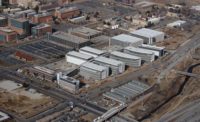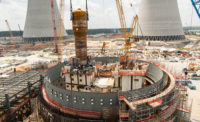The design-builders opted to build the central utility plant with three centrifugal chillers, three hot water boilers and a steam system that Bailey says is "much smaller than you might expect" to serve the hospital's steam needs for sterilization and humidification.
To conserve water, condensate runoff from the HVAC system cooling coils is pumped to the cooling towers for makeup water.
The approach amounts to a significant water-conservation measure, says Bailey, who estimates that the amount of water saved from the collection of condensate will total as much as 3 million gallons a year, or nearly 25% of the cooling tower makeup water.
The biggest energy saver is the inclusion of variable-speed drives on all pumps and fans, says the designer. Bailey says that one of a hospital's biggest uses of energy comes from the requirement to create a system where air volume is constant.
In the past, building designers utilized constant-volume air systems to maintain positive or negative pressure relationships between spaces to control airborne infections, Bailey says.
On MACH, however, designers incorporated what Miller calls a "robust" building automation system that maintains the building's minimum air change requirements at all times. For this reason, the team was able to utilize variable air volume (VAV) systems to maintain minimum required airflows and thereby reduce the facility's future energy use.
Bailey estimates that when compared with a constant volume, multiple-zone reheat system, MACH's VAV system achieves a roughly 30 to 40% reduction in energy use.
"It achieves a tremendous amount of energy savings," Bailey says, "because of the reduction in reheat energy at the zone level, [which] minimizes the amount of simultaneous heating and cooling that normally would be going on in a constant-volume system."
So far, MACH is ahead of schedule for LEED Silver, the builders say. Miller says USGBC approved all 27 of the project's design-phase credits, and if the team is able to secure all 13 construction-phase LEED credits, the project should earn the higher LEED-Gold status.
To the builders, though, nearly all of the project's pluses can be attributed to the use of integrated BIM. "We could not have made the 1,200 days without it," Miller says.












Post a comment to this article
Report Abusive Comment